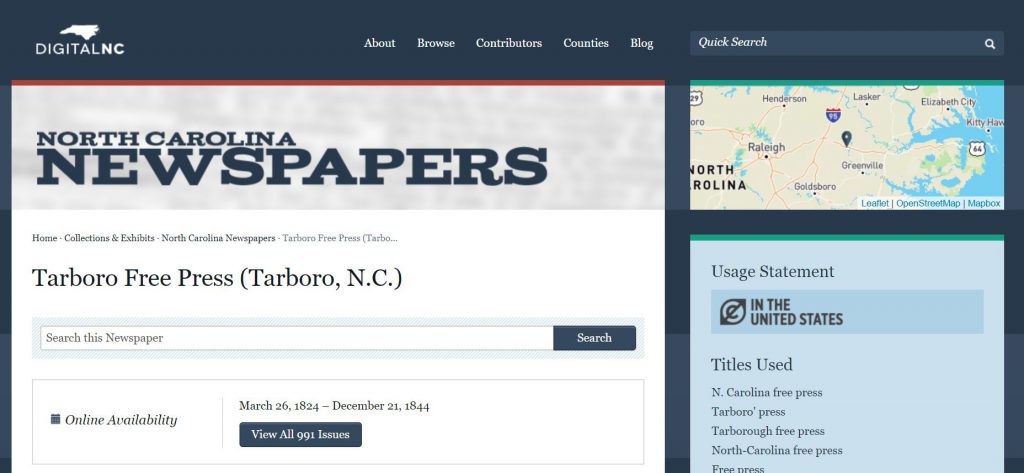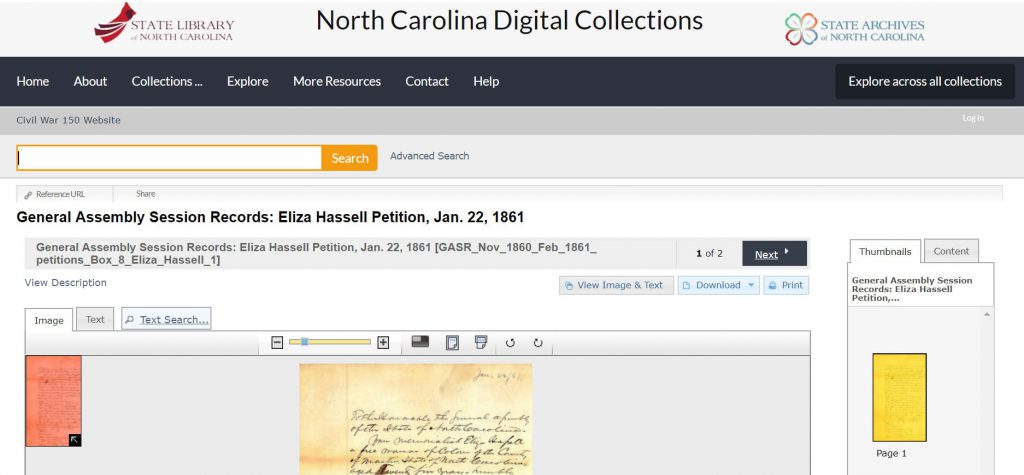After multiple class sessions introducing our archival and manuscript collections and oral history best practices, students in Dr. Nneka Dennie’s Spring 2019 AFR 329: Women & Slavery in the Black Atlantic course produced a documentary using oral histories created throughout the semester. These materials will be donated to the Archives.
In addition to this main project, students were tasked with identifying primary sources from local archives, historic sites, and/or repositories that shed light on the lived experiences of enslaved women or women enslavers. The following series of blog posts are authored by these students upon the completion of this archival research process and serve as reflective pieces.
Thank you for your submissions-and a wonderful semester of fruitful collaborations!
“The Trial and Sentencing of Mass”
written by Laura Auberry
On Nov. 7th, 1826, the Tarboro Free Press included a short summary of a case tried in the Superior Court. The summary describes the case of a female slave named Mass, who had killed her master Mr. Mulford. In her trial, the only witness on the part of prosecution was a boy, who was the son of Mass. This source describes the boy’s testimony as being “very clear, and very positive.” Mass was found guilty by a jury and was executed on Friday the 27th.
This short source indicates much about the life of an enslaved woman in North Carolina. One of the most prominent abuses that occurred during the life of an enslaved woman was sexual abuse from her enslaver. In the case of Mass, the source does not contain an explicit indication of sexual abuse from Mr. Mulford (the enslaver). However, my questions about the case do indicate a high possibility of sexual abuse having occurred.
The first question I have about this source is how the killing of Mr. Mulford happened. I would consider the possibility that Mass poisoned Mr. Mulford, except the use of the word “killing” steers me away from that possibility. While enslaved women did sometimes poison their enslavers as a form of resistance, poisoning does seem to be an act that has to be premeditated, which would shift the word “killing” to “murdering.” Since the term used in this source is “killing,” it suggests that the death of Mr. Mulford was not premeditated. Though the source later describes the crime as “murder,” this can be attributed to the fact that in 1826, an enslaved black woman could not be raped in the eyes of the law.
Enslaved black women were seen as being promiscuous and as always welcoming sexual relations. Therefore, if black women could not be raped, then the court would not recognize self-defense against rape, causing the crime to only be listed as a murder, even though the source describes it as a “killing.” This reasoning leads me to believe that Mass acted in self-defense in the killing of Mr. Mulford. Mass would not be the only enslaved woman to resist sexual violence from her enslaver through self-defense.
Mass’s likely forced sexual relationship with Mr. Mulford also brings up another question about this source. Who was the son of Mass that testified against her? This source mentions that the son of Mass, was the only witness from the prosecution. This indicates that the killing occurred in the home of Mass, where she and her son likely lived together. There is also a possibility that due to the sexual relationship between Mr. Mulford and Mass, the son of Mass could also be the son of Mr. Mulford. While the source does not indicate a relationship, the boy certainly could have been an unacknowledged son. It is difficult to imagine what this boy faced when he most likely saw the death of his father and perhaps, repeated assaults on his mother.
When reading this source, one wonders if this testimony was forced, and what sort of relationship existed between the mother and son. This source also suggests that the son was the only witness “on the part of the prosecution.” This distinction indicates that there were perhaps more witnesses on the part of Mass’s defense. Personally, I wonder, whether Mass received a defense, and what arguments were made against the prosecution. Perhaps the defense did try to argue that Mass was defending herself and called up witnesses to talk on the sexual violence Mass suffered from Mr. Mulford, or Mass’s character. However, this source will not tell us that information. It only mentions Mass’s son, who told his testimony against his mother “very clear[ly] and positive[ly].”
Mass’s trial displays multiple conflicting thoughts about enslaved women. Enslaved individuals were thought of in 1826 as lacking intelligence, morals, and rational thought. Often the paternalistic attitude towards slavery labeled enslaved individuals as children, who needed the guiding hand of their enslaver. However, as this source indicates, when it came criminal punishment, Mass was considered rational enough to be guilty of killing her enslaver and paying for her crime. Her son was also considered intelligent enough to give a clear testimony and be the only witness of the crime. This contradiction was one of many that existed within the institution of slavery.
Source:
Wil. Rec. Tarboro Free Press. Nov. 7th, 1826. North Carolina Newspapers. Accessed April 19th, 2019. http://newspapers.digitalnc.org/lccn/sn92073983/1826-11-07/ed-1/seq-3/.








